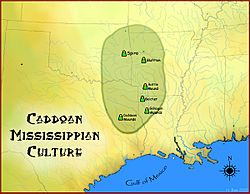Gahagan Mounds Site facts for kids

Map of the Caddoan Mississippian culture and some important sites, including the Gahagan Mound Site
|
|
| Location | Harmon, Louisiana, Red River Parish, Louisiana, |
|---|---|
| Region | Red River Parish, Louisiana |
| Coordinates | 32°2′25″N 93°24′19″W / 32.04028°N 93.40528°W |
| History | |
| Founded | 900 CE |
| Cultures | Caddoan Mississippian culture |
| Site notes | |
| Excavation dates | 1912, 1939, |
| Archaeologists | Clarence Bloomfield Moore, Clarence H. Webb |
| Architecture | |
| Architectural styles | Platform mounds, Burial mound, Plaza |
| Responsible body: private | |
The Gahagan Mounds Site is an ancient place in Red River Parish, Louisiana. It's an archaeological site from the early Caddoan Mississippian culture. This culture was a group of Native Americans who lived in parts of what is now the southeastern United States. The site is found in the Red River Valley. It became famous because of special burials and amazing items found there long ago.
Contents
What is the Gahagan Mounds Site?
The Gahagan Site is on the west side of the Red River in Louisiana. It's located between the cities of Natchitoches and Shreveport. This area was once near an old river channel. However, the river has moved over time, and some parts of the site are now gone.
People lived at the Gahagan Site between the years 900 CE and 1200 CE. The site had a large flat mound, called a platform mound. It also had a cone-shaped burial mound where people were buried. There was a living area around a central open space, known as a plaza. Another smaller mound was located a bit farther away.
Discoveries at Gahagan Mounds

The burial mound at Gahagan was explored twice. The first time was in 1912 by Clarence Bloomfield Moore. Later, in 1939, Clarence H. Webb led another excavation. During these two digs, archaeologists found three deep burial shafts. These shafts held the remains of fourteen people. They also contained over five hundred special items buried with them.
The first shaft found was about 11 feet deep. It was about 13 feet long and 8 feet wide. The other two shafts, found in 1939, were even larger. One was 19 feet long and 15 feet wide. The other was 12 feet long and 11 feet wide.
Amazing Items Found
The items found in the burials were very special. They included finely carved flint knives, now called Gahagan blades. There were also unique earrings made of copper, shaped like faces. Archaeologists found statues and pipes made from Missouri flint clay. Other finds included copper ear ornaments and decorated copper plates. Tools made of greenstone, like celts and spuds, were also discovered. Many beads and arrowheads were found too.
Many of these items were not from the Gahagan area. They came from far away places like the Gulf Coast, central Texas, Tennessee, Kentucky, and the Great Lakes. This shows that the people at Gahagan were part of a large trade network. They might have also been connected to important religious groups across the continent, like the Southeastern Ceremonial Complex.
Most of the human remains and grave goods were given to the Louisiana State University Museum of Natural Science. Some were donated by the Peabody Museum of Archaeology and Ethnology at Harvard University, and more later by Dr. Webb.
What are Gahagan Blades?
Among the burial items at Gahagan were beautiful stone knives. These knives are now known as Gahagan blades. They have also been found at other Caddoan sites, such as the Caddoan Mounds State Historic Site.
Archaeologists believe these blades came from west of the Caddo territory, in central Texas. They were made from a type of rock called chert found in that area. It is thought that groups in central Texas made these blades specifically to trade with other communities.


